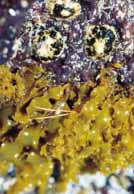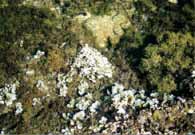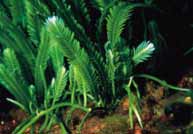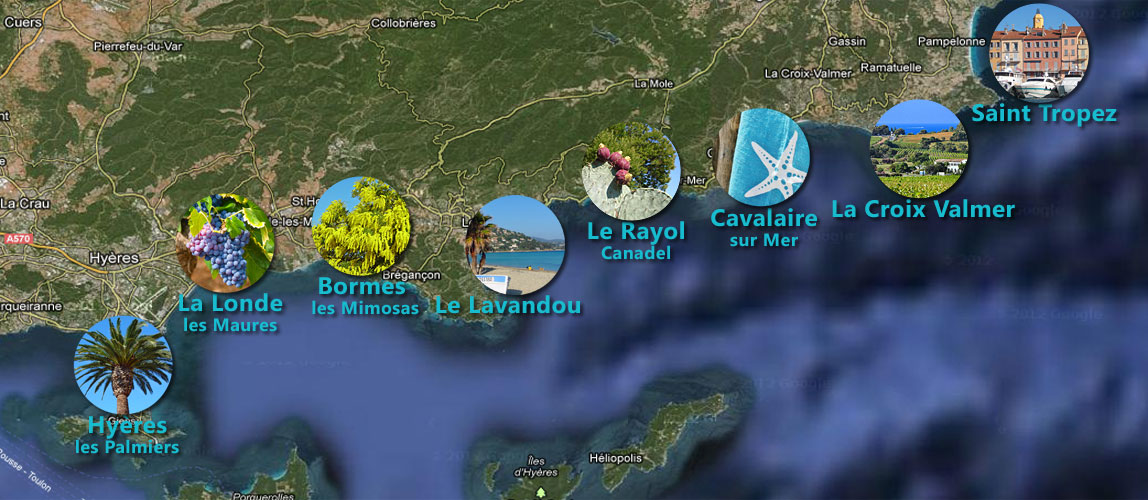Meeresflora im Mittelmeer
On Var coast, there are practically no tides due to the lunar cycle, but of the variations of the marine level can be observed, had with the action of winds perpendicular to the coast and the atmospheric pressure.
The endemic species made a success of so much well their adaptation which they evolved/moved and are not identical any more to their species of origin; it is also for that that the Mediterranean does not resemble any other sea! The distribution of the organizations scrupulously follows the limit of moistening by the spray or the waves. This distribution also depends on the hydrodynamic of the zone, i.e. if it is or not with the shelter of the waves. This vertical distribution is called staging..
Supralitorale Schicht Connection between the sea and the ground, it is never immersed, but receives spray, what makes this medium very difficult for the acclimatization of the life. It is often tiny room to a narrow band. Only the encrusting species are able to colonize it, like some lichens. You will find there in particular a small crab which runs on the rocks..
Mittellitorale Schicht It corresponds to the zone of swinging of the tides and the waves. In the Mediterranean this stage is limited to a few tens of centimetres. The organizations must thus be able to support the alternation of immersions and emergences. It is divided into two horizons: the superior where barnacles and patellas and the inferior live where push calcified red alga..
Infralitorale Schicht Permanently immersed, it is the privileged field of Posidonie and other plants with flowers. It is the stage of the maximum biodiversity for the marine environment. The types of substrate are varied; you will not find the same species on movable substrates and hard substrates.
Under water, one finds a flora made up of algae, plants lower and plants than flowers, higher plants which started to evolve/move on ground then which is turned over to the sea. The chlorophyllian plants are those able to produce their own organic matter by the absorption of mineral matters and luminous energy, thanks to photosynthesis. Whatever its dimension, micro alga in Posidonia, the vegetation is the starting point of the food chains; it is thus important to preserve it because it is also used of shelter and spawning ground. |
Pflanzen mit Blumen
• Posidonia (Posidonia oceanica)
The posidonia is one of the rare plants with flowers (phanerogames) with being able to live out of sea water. It has long ribboned sheets from 20 to 80 cm according to seasons' and of a width from approximately 1 cm. The sheets are organized in beams, themselves attached to crawling or drawn up stems (rhizomes). Although one found and dated from the 4000 years old rhizomes,  they push very slowly: 1 to 5 cm per annum. The posidonia form of vast herbaria which offer to fish various shelters, spawning grounds… All the year, the posidonia lose their old browned sheets; but it is in autumn, after the first storms, that this loss is most important and most visible. The remains of the sheets are rejected on the beaches where they form benches. At first sight the benches can appear dirty, but they protect the beaches from sand of erosion. One also finds on the beaches of the small fibre balls (aegagropiles) coming from the base of the sheets of the posidonia which is imputrescible; rolled by the currents, they agglomerate between them. The settlements are a mixture of species living on hard substrates and movable substrates; it is what makes their originality and their diversity. Some compare these herbaria with forests. Its inhabitants are discrete: they are camouflaged, hide or are often small size. Algae can also choose this support to develop. In time, species follow one another; such an amount of the place is coveted; however 1 square meter of herbarium offers a leaf area from 20 to 50 square meters! It is a very rich ecosystem: it produces 2 times more oxygen than the virgin forest! The posidonia is endemic in the Mediterranean (it is the only place where it is found), what makes our funds single! It extends from the first meters under surface up to 20 to 40 meters of depth; after, it misses light. Protected species. The posidonia are the lung of the Mediterranean. They reject up to 14 litres of oxygen per square meter and day. they push very slowly: 1 to 5 cm per annum. The posidonia form of vast herbaria which offer to fish various shelters, spawning grounds… All the year, the posidonia lose their old browned sheets; but it is in autumn, after the first storms, that this loss is most important and most visible. The remains of the sheets are rejected on the beaches where they form benches. At first sight the benches can appear dirty, but they protect the beaches from sand of erosion. One also finds on the beaches of the small fibre balls (aegagropiles) coming from the base of the sheets of the posidonia which is imputrescible; rolled by the currents, they agglomerate between them. The settlements are a mixture of species living on hard substrates and movable substrates; it is what makes their originality and their diversity. Some compare these herbaria with forests. Its inhabitants are discrete: they are camouflaged, hide or are often small size. Algae can also choose this support to develop. In time, species follow one another; such an amount of the place is coveted; however 1 square meter of herbarium offers a leaf area from 20 to 50 square meters! It is a very rich ecosystem: it produces 2 times more oxygen than the virgin forest! The posidonia is endemic in the Mediterranean (it is the only place where it is found), what makes our funds single! It extends from the first meters under surface up to 20 to 40 meters of depth; after, it misses light. Protected species. The posidonia are the lung of the Mediterranean. They reject up to 14 litres of oxygen per square meter and day.
• Cymodocea (Cymodocea nodosa)
It resembles the posidonia but its sheets are narrower. It needs much light. It is also protected. The herbaria are very sensitive to the pollution and the factor of destruction which the anchoring of the boats represents. An anchor can tear off a large quantity of rhizomes, what can represent several years of growth, but also a zone where the herbarium will be weakened by the currents or the arrival of other algae. The posidonia is generally propagated and reproduced by propagation by cutting. It flowers exceptionally and gives fruits then; olives of sea. Protected species.. |
Algen
Algae are divided into three groups: the green ones, reds, and the brown ones. Their classification would be too simple if it depended on their colour! It is in fact the characteristic of the pigments enabling them to carry out their photosynthesis which determines their classification in such or such group. A brown alga like the padines, limestone rich person, can be almost white and a red alga, for example the rissoelle one, is yellow green. Small course of scientific vocabulary, because as they are not higher plants, one does not speak about plant but about thallus, no sheets but of slings, no roots but of cramps, the rhizoid ones or let us stolons.
 • Rissoelle - Rotalge (Rissoella verruculosa) • Rissoelle - Rotalge (Rissoella verruculosa)
This ribboned alga calcifuges is more or less corrugated and curly. Its colour draws towards the yellow and its consistency is rubbery. It pushes in top of the zone of swinging of the tides, flees the rocks limestone and prefers pure and agitated wate.
• Dictyote oder Algengabel - Braunalge
(Dictyota dichotoma)
It is an alga present under surface. It presents green and translucent thin straps with characteristic bluish reflections. These thin straps are always divided into two at the time of the growth, from where the name of this alga. It resembles another brown alga which has a vein in the center of the thin straps..
• Cystoseira Mittelmeer - Braunalge.
(Cystoseira mediterranea)
It’s endemic. It needs much light and appreciates the rocks beaten by the waves on the surface. It is an indicator bio of pollution. It is present all the year. It often forms a belt of color green olive, but loses its branches in autumn.
• Codiumschwellung - Grünalge (Codium bursa)
You certainly already saw these green balls rejected on sand by the undertow: they are not sponges but indeed algae. They can reach diameters of 40 cm and are then flattened in the center. They can accommodate inside the reddish
• Fächerförmige Padine - Braunalge (Padina pavonica)
Very common on the rocks, this alga seeks the light towards surface. It is rich in limestone, what gives him a certain rigidity and its almost white colour. It’s an alga extremely easy to recognize..
• Ulva - grüne Alge (Ulva Lactuca)
It is a green membrane, crushed and fixed at the rocks by a small cramp. Sometimes one finds it on the beaches, torn off by the currents. It supports brackish or slightly polluted water.
Mittleres Küstenniveau.
• Zerbrechliches Codium - Grünalge (Codium vermilara)
This alga originating in the Pacific arrived in our water since about fifty years by the Straits of Gibraltar. Its green cylindrical branches are characteristic
• Acetubular - Grünalgen (Acetubularia acetubulum)
This alga originating in the Pacific arrived in our water since about fifty years by the Straits of Gibraltar. Its green cylindrical branches are characteristic
 • Caulerpa mit Eibenblättern - Grünalge (Caulerpa Taxifolia) • Caulerpa mit Eibenblättern - Grünalge (Caulerpa Taxifolia)
This alga of tropical origin, introduced accidentally in the Mediterranean since a few years, makes impressive great strides. It enters in competition with the natural environment and changes the underwater landscape. Its slings fluorescent green resemble feathers. If you find some, especially do not try to set out again with a sample. It with the capacity to push back elsewhere starting from a very small piece. Then if you want to avoid his propagation, wisest is to announce its presence. Therefore it became a protected species. If you are yachtsman, check if it were not invited on your board by taking the air on your anchor. If it is the case, do not reject it anywhere: put it in a dustbin. Protected species.
• Caulerpa vermehrte sich - Grünalge (Caulerpa prolifera)
This alga is thermophilous; it does not appreciate that the temperature falls under 13°C. Its slings resemble true sheets; they are carried by a stolons which “crawls” on the funds muddy sand. This Caulerpa often pushes on small surfaces in the middle of phanerogames. It’s found all the year
|

|
|
|
|


